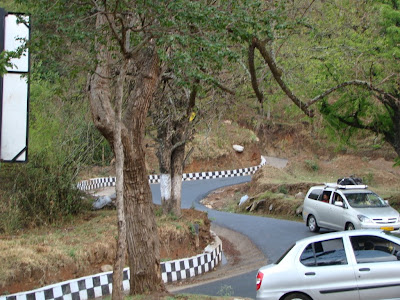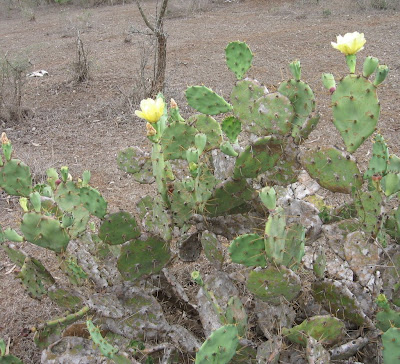3 day long weekend on May 1, provided us with a perfect opportunity to explore the Nilgiris. On Friday morning, we were on our way to India's popular hill station, Ooty. As we did not wish to reach our destination in a hurry, we stopped, exclaimed at various places we found interesting, allowing the Ford fiesta to breathe easy.
First among these places was Nanjanagudu. After getting past royal city of Mysore, on way to Gundlupete you will find Nanjanagudu famous for its majestic Nanjundeshwara Temple. Bridge across river Kabini is what caught our attention. Well, there is not one but 3 bridges across river Kabini - two railway bridges one of which is not functional and one for motor vehicles to pass through. Railway bridge which is not used now, looks like a series archs.



Here is the route we followed from Bangalore to reach Ooty : Bangalore - Mysore - Nanjanagudu - Gundlupete - Bandipur Forest - Mudumalai Forest - Theppakadu - Kalhatti Ghat - Ooty (for a easy drive you can avoid Kalhatti and go via Gudalur route)
Click here to read the Kannada version of this article.
Also read,
Ooty Trip : Part 2 - Coonoor, Kotagiri, Kodanad Viewpoint
Ooty Trip : Part 3 - Ooty Botanical Gardens, Dodda betta, Shooting Medu
Raveesh




First among these places was Nanjanagudu. After getting past royal city of Mysore, on way to Gundlupete you will find Nanjanagudu famous for its majestic Nanjundeshwara Temple. Bridge across river Kabini is what caught our attention. Well, there is not one but 3 bridges across river Kabini - two railway bridges one of which is not functional and one for motor vehicles to pass through. Railway bridge which is not used now, looks like a series archs.

Nanjanagudu Railway Bridge
Information board by South Western Railway near the bridge says - "It was built by Dalvoy Devraj in 1735 with brick, sand and stone adopting ancient Gothic style. It was strong and wide enough to carry road traffic as well as metre guage trains, which started running in 1889. This ancient bridge today stands as an engineering marvel, which bears testimony to the skills of those who built it. This bridge now over 270 years old and could very well be the oldest railway bridge in the world because the first railways was built only after 1825 and there were no other known cases of ancient road bridges having been used to carry railway traffic".
Roads inside Bandipur forest
After Gundlupete, one enters the Bandipur forest. Nice roads in middle of the forest - it was place to take those photographs for Desktop backgrounds! Soon after crossing the Tamil Nadu border at Kakkanalla, travelling via Mudumalai forest area, we witnessed an area covered with gulmohar trees. Ground covered with Gulmohar flowers, giant trees and a stream nearby was a treat to our eyes.
Gulmohar Trees near Tamil Nadu border area
Not only green pastures, a barren land on backdrop of hills was also on our visited list. We happened to see the Cactus flower there! On way to Ooty at Theppakadu junction, we had the option of choosing two roads to go to Ooty - shorter one via Kalhatti Ghat road or longer one passing via Gudalur. We chose the former without knowing the obstacles ahead. Kalhatti ghat road is the one where you have to negotiate 36 hair pin turns and the drive was daunting to say the least. With it started raining, it was more difficult. After crossing ghat road, we were cruising to Udhagamandalam going past road between tall, lanky trees - scenes most shot by Indian film fraternity.
Kalhatti Ghat Road
First thing I could notice in Ooty was that it was very crowded place. But well, Udhagamandalam, Ootacamund, Whadacamund, Wotkymund or simply Ooty, is an exquisite place for tourists. Metaphors too fail to capture its vastness in words - Scotland of the East, Big Queen of the Nilgiris hardly suffice. More on Ooty and surrounding places in upcoming posts.Here is the route we followed from Bangalore to reach Ooty : Bangalore - Mysore - Nanjanagudu - Gundlupete - Bandipur Forest - Mudumalai Forest - Theppakadu - Kalhatti Ghat - Ooty (for a easy drive you can avoid Kalhatti and go via Gudalur route)
Click here to read the Kannada version of this article.
Also read,
Ooty Trip : Part 2 - Coonoor, Kotagiri, Kodanad Viewpoint
Ooty Trip : Part 3 - Ooty Botanical Gardens, Dodda betta, Shooting Medu
Raveesh

Kalhatti Ghat Road [Thanks nidhi for this picture]

Cactus flower

Trip gang with Ford fiesta

Ooty is nearing
If it's not for railways why they had constructed bridge in 1735 ?
ReplyDeleteFrom the post - It was built by Dalvoy Devraj in 1735 with brick, sand and stone adopting ancient Gothic style. It was strong and wide enough to carry road traffic as well as metre guage trains, which started running in 1889.Before the British Raj, it was built for road traffic in 1735. Then British used it for railway traffic in 1889.
ReplyDelete